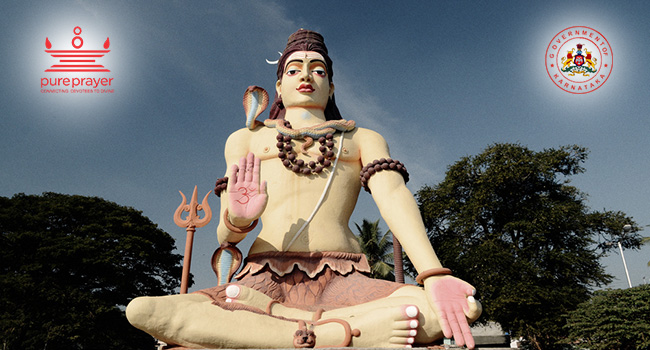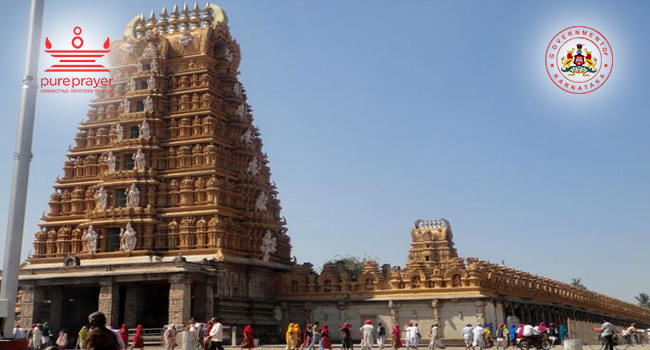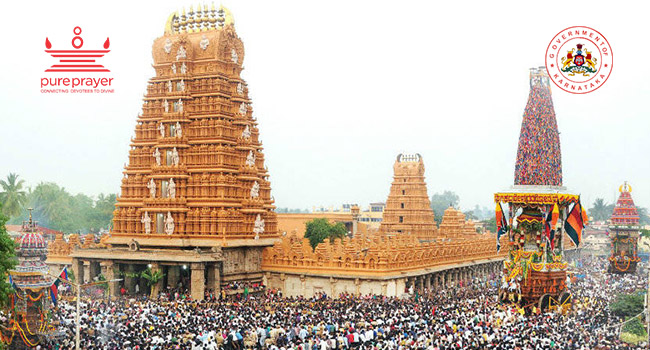History
-
Puranic background / ಪೌರಾಣಿಕ ಹಿನ್ನೆಲೆ

According to legends, the greatness of Nanjangud was once explained by Suta Puranic to Sage Shaunaka. When Goddess Parvati and Lord Parameshwara were on a sojourn, the former requested Lord Parameshwara to tell her about a sacred place on earth. Lord Parameshwara explained to his wife Parvati Devi that a place called Garalapuri, where Kapila and Kaundini Rivers join together, was very auspicious, vibrant and sacred. The name of this place became Garalapuri because of the fact that the venom that emanated during Great Churning of Mount Meru was swallowed by Lord Shiva. Goddess Parvati felt that the life of Shiva was in danger and therefore held his neck with her hands so that the venom did not go down. As a result, the venom deposited at the throat of Lord Shiva. Sage Kapila is said to have done penance in this place. Srirama, when he was searching for Seetha, who had been abducted by Ravana, had come to Garalapuri and taken a dip in Kapila River. Sage Vasishtha’s wife Arundhati, and Indra’s wife Shachi Devi had also taken bath in this river. Even Aditi, the wife of sage Kashyapa, took a dip in the union of two rivers Kapila and Kaundinya with a desire of begetting children. Susheeka Devi, wife of Kaundinya Maharishi, took a bath at the union of two rivers and performed Sri Ananta Vrata on its banks. Goddess Earth is said to have appealed to Lord Shiva to stay at Garalapuri and the latter conceded her demand. As demon Keshi was killed in this place, the soil here has great medicinal qualities and it cures all types of ailments and diseases. This quality has been sanctioned by Lord Shiva, who stays here in a distinct form. When Parvati and Parameshwara were bathing in Kapila River, a pearl in the crown of Lord Shiva is said to have fallen in the waters and hence this place came to be known as Manikarnika Ghatta. Under the auspices of Lord Shiva, Ganga started flowing along with Kapila here, albeit as an invisible stream. Parusharama beheaded his mouther Renukadevi under the instructions of his father and makes her alive by requesting his father to that effect, which was bestowed upon in the form a boon. He got relieved from the negative energy of having killed the mother by applying a paste prepared with the soil of this land. This further sanctified Nanjangud. ಇಲ್ಲಿ ಪ್ರಚಲಿತವಿರುವ ದಂತಕಥೆಗಳು ಅನೇಕ. ಶೌನಕಾದಿ ಮಹರ್ಷಿಗಳಿಗೆ ಸೂತಪುರಾಣಿಕರು ಈ ಕ್ಷೇತ್ರದ ಮಹಿಮೆಯನ್ನು ವರ್ಣಿಸಿದರೆಂದು ಹೇಳಲಾಗುತ್ತದೆ. ಈ ಕ್ಷೇತ್ರದ ಮಹಿಮೆಯನ್ನು ಸ್ಕಾಂದವೇ ಮೊದಲಾದ ಅನೇಕ ಪುರಾಣದಲ್ಲಿ ಹೇಳಲಾಗಿದೆ. ಒಮ್ಮೆ ಪಾರ್ವತೀಪರಮೇಶ್ವರರು ಸಂಚಾರಮಾಡುತ್ತಿರುವಾಗ, ಶ್ರೀ ಪಾರ್ವತೀದೇವಿಯು ತಮಗೆ ಸುಖದಾಯಕವಾದ ಕ್ಷೇತ್ರಗಳಲ್ಲಿ ಪರಮಪವಿತ್ರವಾದ ಮತ್ತು ಪರಮೋತ್ಕೃಷ್ಟವಾದ ಕ್ಷೇತ್ರವಾವುದೆಂದು ಕೇಳಿದ್ದಕ್ಕೆ, ಕಪಿಲಾ ಕೌಂಡಿನೀ ನದಿಗಳ ಸಂಗಮಸ್ಥಳವಾದ ಗರಳಪುರಿ ಕ್ಷೇತ್ರವೇ ಪರಮಪಾವನವಾದ ಕ್ಷೇತ್ರವೆಂದು ಪರಮಶಿವನು ನುಡಿಯುತ್ತಾನೆ. ಪರಮೇಶ್ವರನು ಕೇಶೀ ರಾಕ್ಷಸನನ್ನು ಇದೇ ಕ್ಷೇತ್ರದಲ್ಲಿ ಸಂಹರಿಸಿದನು. ಈ ಕ್ಷೇತ್ರಕ್ಕೆ ‘ ಗರಳಪುರಿ’ ಎಂಬ ಹೆಸರು ಏಕೆ ಬಂದಿತೆಂಬ ಪ್ರಶ್ನೆಗೆ ಸೂತ ಪುರಾಣಿಕರು ಹೀಗೆ ಹೇಳಿದರು: ಸಮುದ್ರಮಥನ ಕಾಲದಲ್ಲಿ ಹಾಲಾಹಲವೆಂಬ ವಿಷವು ಹುಟ್ಟಿತು. ಪರಮೇಶ್ವರನು ಲೋಕೋದ್ಧಾರಕ್ಕಾಗಿ ಆ ಹಾಲಾಹಲವನ್ನು ಧರಿಸುವಲ್ಲಿ ಒಂದು ತೊಟ್ಟು ವಿಷವು ದರ್ಭೆಯ ಮೇಲೆ ಬಿತ್ತು. ಆ ವಿಷಸಂಭದದಿಂದ ಪರಮಶಿವನು ಇಲ್ಲಿ ನಿಂತಿದ್ದರಿಂದ ಇದಕ್ಕೆ “ ಗರಳಪುರಿ” ಅಥವಾ “ ನಂಜನಗೂಡು” ಎಂಬ ಹೆಸರು ಬಂದಿತು. ಶ್ರೀರಾಮನು ಸೀತೆಯನ್ನು ಹುಡುಕುವಾಗ ಈ ಕಪಿಲಾ ನದಿಯಲ್ಲಿ ಸ್ನಾನಮಾಡಿ ನಿತ್ಯಕರ್ಮಗಳನ್ನು ನೆರವೇರಿಸಿ ಶುಚಿರ್ಭೂತನಾದನೆಂದು ಹೇಳಲಾಗುತ್ತದೆ. ವಶಿಷ್ಠ ಪತ್ನಿಯಾದ ಅರುಂಧತಿಯೂ ಇಂದ್ರಪತ್ನಿಯಾದ ಶಚಿದೇವಿಯೂ ಈ ನದಿಯಲ್ಲಿ ಸ್ನಾನಮಾಡಿ ರೂಪವತಿಯರಾಗಿ ಬೆಳಗಿದರು. ಕಶ್ಯಪಪತ್ನಿಯಾದ ಅದಿತಿಯೂ ಪುತ್ರಾರ್ಥಿನಿಯಾಗಿ ಈ ನದಿ ಸಂಗಮದಲ್ಲಿ ಮುಳುಗಿ ದೇವರಾಜಾದಿ ಸುತರನ್ನು ಪಡೆದಳು. ಕೌಂಡಿನ್ಯ ಋಷಿಗಳ ಪತ್ನಿ ಸುಶೀಲಾದೇವಿಯೂ ಅನಂತನ ವ್ರತವನ್ನು ಮಾಡಿ ಸಕಲ ಇಷ್ಟಾರ್ಥವನ್ನೂ ಪಡೆದಳು. ಭೂ ದೇವಿಯೂ ತನ್ನ ಮೇಲೆ ಬಿದ್ದ ವಿಷವನ್ನು ಸೇವಿಸಿ ಮಹದುಪಕಾರ ಮಾಡಿದುದ್ದಕ್ಕಾಗಿ ಶ್ರೀ ಶಂಕರನನ್ನು ಬಹಳವಾಗಿ ಸ್ತುತಿಸಿ, ತನ್ನಲ್ಲಿಯೇ ವಾಸಿಸಬೇಕೆಂದು ಕೇಳಿಕೊಂಡಳಾದ್ದರಿಂದ ಸಾಂಭಮೂರ್ತಿಯೂ ಈ ಗರಳಪುರಿಯಲ್ಲಿಯೇ ನಿಂತುಬಿಟ್ಟನು. ಈ ಕ್ಷೇತ್ರವೂ ಕೇಶೀಸಂಹಾರ ಸ್ಥಳವಾದ್ದರಿಂದ ಭೂಮಿಯೂ ಮೃತ್ತಿಕೆಯಾಗಿ ಇದರಿಂದ ಸಮಸ್ತಭೀಷಣವಾದ ರೋಗಗಳೂ ನಿವಾರಣೆಯಾಗುವಂತೆ ಪರಶಿವನು ವರವಿತ್ತಿ ಶ್ರೀ ಸಂಗಮೇಶ್ವರನೆಂಬ ಹೆಸರಿನಲ್ಲಿ ನೆಲೆಸಿದ್ದಾನೆ. ಪಾರ್ವತೀಪರಮೇಶ್ವರರು ಕಪಿಲಾನದಿಯಲ್ಲಿ ಜಲಕ್ರೀಡೆಯಾಡುವಾಗ ಸ್ವಾಮಿಯ ಕಿರೀಟದಲ್ಲಿ ಒಂದು ಮಣಿಯು ಬಿದ್ದು ಹೋಯಿತು. ಆ ಜ್ಞಾಪಕಾರ್ಥವಾಗಿ ಮಣಿಕರ್ಣಿಕಾಘಟ್ಟ ಎಂದು ಹೆಸರು ಬಂದಿತು. ಪರಮೇಶ್ವರನ ಅಪ್ಪಣೆಯಂತೆ ಗಂಗೆಯೂ ಇಲ್ಲಿ ಗುಪ್ತಗಾಮಿನಿಯಾಗಿ ಇಲ್ಲಿ ನಿಂತಳು. ಪರಶುರಾಮನು ತಂದೆಯ ಆಜ್ಞಾನುಸಾರವಾಗಿ ತಾಯಿಯಾದ ರೇಣುಕಾ ದೇವಿಯ ಶಿರವನ್ನು ಛೇದಿಸಿದ ಕೂಡಲೇ ತಂದೆಯ ವರದಿಂದ ರೇಣುಕಾ ದೇವಿಯನ್ನು ಬದುಕಿಸಿಕೊಂಡನು. ಭೂ ಕೈಲಾಸವಾದ ಈ ಗರಳಪುರಿ ಕ್ಷೇತ್ರಕ್ಕೆ ಬಂದು ತಪೋಸ್ಥಳವನ್ನು ನಿರ್ಮಾಣ ಮಾಡುವುದಕ್ಕಾಗಿ ವಿಷಪ್ರಕರಿ ಗಿಡವನ್ನು ತನ್ನ ಕೊಡಲಿಯಿಂದ ತರಿಯಲು, ಸ್ವಾಮಿಯ ತಲೆಗೆ ಏಟು ಬಿದ್ದು ರಕ್ತ ಹರಿಯಿತು. ಪರಶುರಾಮನಿಗೆ ಗಾಬರಿಯಾಗಿ ದಿಕ್ಕುತೋರದೆ ನಿಂತಿರಲು, ಸ್ವಾಮಿಯು ಪ್ರತ್ಯಕ್ಷನಾಗಿ ಕೇಶಿಸಂಹಾರಸ್ಥಳದ ಮೃತ್ತಿಕೆ ತಂದು ಗಾಯಕ್ಕೆ ಹಚ್ಚಿಕೊಂಡು ಮಾತೃ ಹತ್ಯಾದೋಷವನ್ನು ನಿವಾರಣೆ ಮಾಡಿದನು.
Historical background / ಐತಿಹಾಸಿಕ ಹಿನ್ನೆಲೆ

The history of Sri Nanjundeshwara temple runs longer than a thousand years. Several kings of different dynasties have made massive and significant contribution towards the development of this temple. Chola Kings are said to have made the first attempt on the construction of this temple in the 11th–12th Century. Later, the Hoysalas and the Vijayanagar kings made it look more sacred, solemn, sublime and impressive. The temple received exemplary and exclusive patronage during the era of Mysore rulers and reached its peak level during the regime of Krishnaraja Wodeyar. ನಂಜನಗೂಡು ಸಹಸ್ರಾರು ವರ್ಷಗಳ ಪೌರಾಣಿಕ ಹಾಗೂ ಐತಿಹಾಸಿಕ ಹಿನ್ನಲೆಯನ್ನು ಹೊಂದಿದೆ. ಅನೇಕ ರಾಜ- ಮಹಾರಾಜರು ಇಲ್ಲಿನ ಸುಪ್ರಸಿದ್ಧ ಶ್ರೀ ಶ್ರೀಕಂಠೇಶ್ವರ ದೇವಾಲಯ ಅಭಿವೃದ್ಧಿಕಾರ್ಯದಲ್ಲಿ ವಿಶೇಷವಾಗಿ ಭಾಗಿಯಾಗಿದ್ದಾರೆ. ಕ್ರಿ.ಶ. 11 -12ನೇ ಶತಮಾನದಲ್ಲಿ ಉಚ್ಛ್ರಾಯ ಸ್ಥಿತಿಯಲ್ಲಿದ್ದ ಚೋಳರು ಈ ದೇವಾಲಯವನ್ನು ನವೀಕರಿಸುವ ಪ್ರಥಮ ಪ್ರಯತ್ನ ನಡೆಸಿದರೆಂದು ತಿಳಿದು ಬರುತ್ತದೆ. ನಂತರದಲ್ಲಿ , ಹೊಯ್ಸಳ ಮತ್ತು ವಿಜಯನಗರದರಸರ ಅವಧಿಯಲ್ಲಿ ಈ ದೇವಸ್ಥಾನವು ಪ್ರಾಮುಖ್ಯತೆ ಪಡೆದು ಹಲವು ರೀತಿಯಲ್ಲಿ ನವೀಕರಣಗೊಂಡಿತು. ಆದಾಗ್ಯೂ, ಮೈಸೂರು ಅರಸರ , ಅದರಲ್ಲೂ ಕ್ರಷ್ಣರಾಜ ಒಡೆಯರ ಕಾಲದಲ್ಲಿ, ನಂಜನಗೂಡಿನ ಶ್ರೀ ಶ್ರೀಕಂಠೇಶ್ವರ ದೇವಾಲಯವು ಅಭೂತಪೂರ್ವ ಏಳಿಗೆಯನ್ನು ಕಂಡಿತೆಂದು ದಾಖಲಾತಿಗಳು ತಿಳಿಸುತ್ತವೆ.
Greatness of Kshetra / ಕ್ಷೇತ್ರ ಮಹಿಮೆ

In Kannada, Nanjunda means one who consumed poison and Eshwara refers to Lord Shiva, who consumed a very strong poison or venom that erupted during the Great Churning of Mount Meru, to save gods and goddesses from its lethal effect. Nanjunda came to be called as Vishakantha and also Srikantha for having digested the venom. Hence, Sri Nanjundeshwara is also known as Srikantheshwara for he is believed to cure all diseases. ನಂಜುಂಡ ಎಂದರೆ ನಂಜು ಅಥವಾ ಹಾಲಾಹಲವನ್ನು ಉಂಡವ, ಎಂದರೆ ಶಿವನೆಂದು ಅರ್ಥವಾಗುತ್ತದೆ. ನಂಜುಂಡೇಶ್ವರ ಪವಿತ್ರ ದೇವಾಲಯವು ಇಲ್ಲಿರುವುದರಿಂದಲೇ, ಹಿಂದೆ ಗರಳಪುರಿ ಎಂದು ಪ್ರಸಿದ್ಧವಾಗಿದ್ದ ಈ ದೇವಾಲಯವು ನಂಜುಂಡೇಶ್ವರ ದೇವಸ್ಥಾನವೆಂದು ಖ್ಯಾತಿ ಪಡೆಯಿತು. ದೇವದಾನವರು ಅಮೃತವನ್ನು ಪಡೆಯಲು ನಡೆಸಿದ ಸಮುದ್ರ ಮಂಥನದಲ್ಲಿ ಹೊರಚಿಮ್ಮಿದ ಹಾಲಾಹಲದಿಂದ ದೇವತೆಗಳನ್ನು ಕಾಪಾಡುವ ಉದ್ದೇಶದಿಂದ ಪರಮಶಿವನು ತಾನೇ ಕುಡಿದನು. ತನ್ನ ಪತಿಯ ಪ್ರಾಣ ರಕ್ಷಣೆಗೆಂದು ಪಾರ್ವತಿಯು, ಶಿವನು ಉಂಡ ನಂಜು ಗಂಟಲಿಂದ ಕೆಳಗಿಳಿಯದಂತೆ ತನ್ನೆರಡು ಕೈಗಳಿಂದ ಶಿವನ ಕಂಠವನ್ನು ಒತ್ತಿ ಹಿಡಿದಳು. ಯಾವುದೇ ಅನಾಹುತಕ್ಕೆ ಆಸ್ಪದವೀಯದೆ ಶ್ರೀ ನಂಜುಂಡನು ಅರಗಿಸಿಕೊಂಡು ನಂಜುಂಡನಾದನು.
Temple Architecture / ದೇವಾಲಯ ವಿನ್ಯಾಸ

Sri Srikantheshwara temple at Nanjangud is one of the largest temples in Karnataka and measures 385 ft. x 160 ft., covering a total area of 50,000 sq. ft. The seven-storied Mahadwara or the main entrance is decorated with seven gold-plated Kalashas that add to its loftiness flanked by two horns. The outer walls of the temple are about 12 ft. high. A spacious courtyard (Prakara) contains a veritable galaxy of stucco figures consisting of over 122 images, including Dikpalas, Lord Shiva and his various manifestations, several forms of Lord Subrahmanya and Saptamatrikas. Of the numerous bronze icons that adorn the walls, those of Sri Thandaveshwara, Sri Narayana with Bhudevi, Sri Chandrashekharamurthy, Parvati Devi and Sri Chandikeshwara are exquisite. The inner niches of the temple wall depict 32 forms of Lord Ganapati, eulogised in Mudgala Purana. ನಂಜನಗೂಡಿನಲ್ಲಿರುವ ಶ್ರೀ ಶ್ರೀಕಂಠೇಶ್ವರ ದೇವಸ್ಥಾನವು ಕರ್ನಾಟಕ ರಾಜ್ಯದ ಅತ್ಯಂತ ವಿಸ್ತಾರವಾದ ದೇವಾಲಯಗಳಲ್ಲಿ ಒಂದಾಗಿದ್ದು 385ಅಡಿ ಉದ್ದ ಮತ್ತು 160ಅಡಿ ಅಗಲದ ನಿವೇಶನದಲ್ಲಿ ನಿರ್ಮಿಸಲ್ಪಟ್ಟಿದೆ. ಇದರ ಒಟ್ಟು ನಿರ್ಮಿತಪ್ರದೇಶವು 50,000 ಚದುರ ಅಡಿಗಳಷ್ಟಿದೆ. ಏಳು ಅಂತಸ್ತಿನ ಮಹಾದ್ವಾರವು ಏಳು ಸುವರ್ಣ ಲೇಪಿತ ಕಲಶಗಳನ್ನು ಹೊಂದಿದೆ. ಗೋಪುರದ ಇಕ್ಕೆಲಗಳಲ್ಲಿ ಎರಡು ಕೋಡುಗಳಿವೆ. ದೇವಾಲಯದ ಬಾಹ್ಯ ಗೋಡೆಗಳು ಹನ್ನೆರಡು ಅಡಿ ಎತ್ತರದ್ದಾಗಿದೆ. ಭವ್ಯ ಮತ್ತು ವಿಸ್ತಾರವಾದ ಪ್ರಾಕಾರದಲ್ಲಿ ದಿಕ್ಪಾಲಕರು ಮಹಾದೇವ ಮುಂತಾದ 122 ದೇವ-ದೇವತೆಗಳ ಚಿತ್ರಣದಿಂದ ಕೂಡಿದೆ. ಮಹಾದೇವನ ವಿವಿಧ ರೂಪಗಳು ಸುಬ್ರಹ್ಮಣ್ಯ ಸ್ವಾಮಿ ಸಪ್ತ ಮಾತೃಕೆಯರ ವಿವಿಧ ಭಂಗಿಗಳ ಮನಮೋಹಕ ಚಿತ್ರಣವು ಈ ಗೋಡೆಯ ಮೇಲೆ ಲಭ್ಯವಿದೆ. ಶ್ರೀ ತಾಂಡವೇಶ್ವರ, ಭೂದೇವಿ ಸಹಿತ ಶ್ರೀಮನ್ ನಾರಾಯಣ, ಶ್ರೀ ಚಂದ್ರಶೇಖರ ಮೂರ್ತಿ, ಪಾರ್ವತೀದೇವಿ ಮತ್ತು ಶ್ರೀ ಚಂಡಿಕೇಶ್ವರರ ಹಿತ್ತಾಳೆ ಮೂರ್ತಿಗಳು ಗೋಡೆಗಳ ಮೇಲೆ ರಾರಾಜಿಸುತ್ತಿದ್ದು ಅವಕ್ಕೆ ಅನಿರ್ವಚನೀಯ ಮೆರುಗನ್ನು ನೀಡಿವೆ. ಒಳಾಂಗಣದಲ್ಲಿ ಶ್ರೀ ವಿಘ್ನೇಶ್ವರನ 32 ರೂಪಗಳನ್ನು ಮುದ್ಗಲ ಪುರಾಣೋಕ್ತಿಯಂತೆ ಬಿಂಬಿಸಲಾಗಿದೆ.



